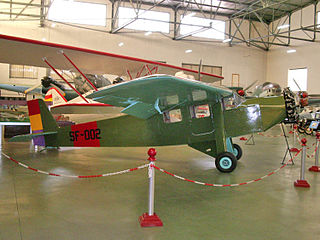
The Farman F 400 was a 1930s French three-seat cabin high-winged monoplane which was designed and built by Farman.

The Farman F.60 Goliath was a French airliner and bomber produced by the Farman Aviation Works from 1919. It was instrumental in the creation of early airlines and commercial routes in Europe after World War I.

The Farman F.120 and its derivatives were a family of multi-engine airliners and bombers of the 1920s built by the Farman Aviation Works in France.

The Farman F.170 Jabiru was a 1925 single-engine airliner evolved from the F.121 Jabiru, built by the Farman Aviation Works.
The Farman F.51 was a 1920s French maritime reconnaissance flying boat designed and built by Farman. The F.51 was an unequal-span four-bay biplane flying boat with a crew of four. It was powered by two Lorraine 8bd engines mounted in tractor configuration. A pusher engined version was designated the Farman F.50 . Tested by the French Navy but it failed to win any orders, Farman did briefly consider a civil version but the project was abandoned.

The Farman F.180 Oiseau Bleu was a 1920s French biplane airliner. The F.180 was designed to fly non-stop between Paris and New York, but when the crossing attempt was cancelled three aircraft were built as luxury transports to operate from Paris to nearby European capital cities for the company's own airline.

The Farman F.70 was a 1920s French passenger and mail transport aircraft designed and built by the Farman Aviation Works. It was a smaller counterpart to the company's popular F.60 Goliath. The F.70 was an unequal-span two-bay biplane with a wooden fuselage and was powered by a Renault 12Fe piston engine. The pilot was seated in an open cockpit behind the nose-mounted engine. Behind the open cockpit was a cabin for four passengers or freight.

The Farman F.160 A.2 was a 1920s French sesquiplane designed as a military reconnaissance and observation aircraft. Only one was built.
The Farman B.2 was a 1920s French biplane designed as a light day bomber. Only one was built.
The Farman F.80 was a 1920s French biplane designed by Farman as a basic trainer.
The Farman F.150 was a 1920s French twin-engined biplane designed by Farman as a day bomber.
The Farman F.130 was a 1920s French biplane designed by Farman as a long-range day bomber.

The Farman BN.4, a.k.a. Super Goliath, was a very large 1920s French biplane designed by Farman as a long-range night bomber.

The Farman F.110 was a French two-seat artillery observation biplane designed and built by the Farman Aviation Works.

The Farman F.211 was a French four-seat day or night bomber designed and built by the Farman Aviation Works for the French Air Force.
The Farman F.270 was a prototype French bomber/torpedo-bomber designed and built by the Farman Aviation Works for the French Air Force.
The Farman F.420 was a twin engine monoplane, built in France in the mid-1930s to compete in a government contest for an aircraft capable of fulfilling bomber, fighter and reconnaissance roles. Two prototypes were constructed but no production followed.

The Farman FF 65 Sport was a French built light biplane, with a single engine and tandem seats, intended for sport and touring. First flown in 1919, it achieved modest sales at home and abroad in the early 1920s. Two unusual modifications produced a biplane glider and a low aspect ratio parasol wing machine.

The Farman F.140 Super Goliath was a very large, four engine biplane night bomber, designed in France in the mid-1920s. Nine flew with the French Air Force until concerns about structural weakness grounded them in 1930. The prototype set several world records for altitude reached with heavy useful loads.
The Adolphe Bernard AB was a twin-engined French biplane aircraft, built near the end of the First World War. Ten AB 1 BN2 bombers were produced for the Armée de l'Air but did not reach squadron service; post-war, two civil derivatives were considered but only one aircraft was built.















